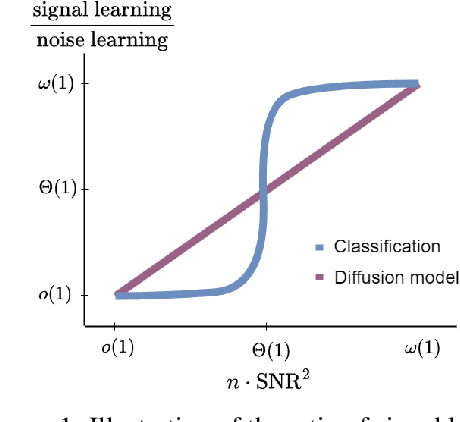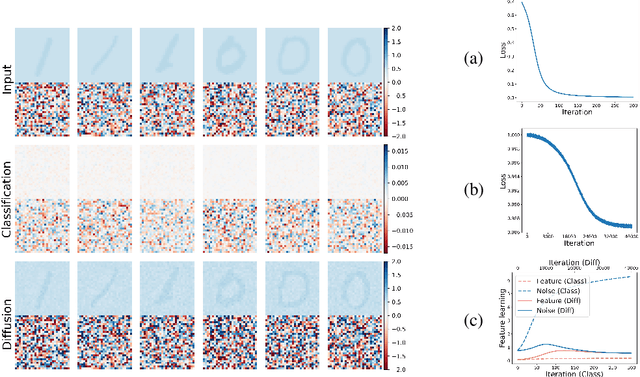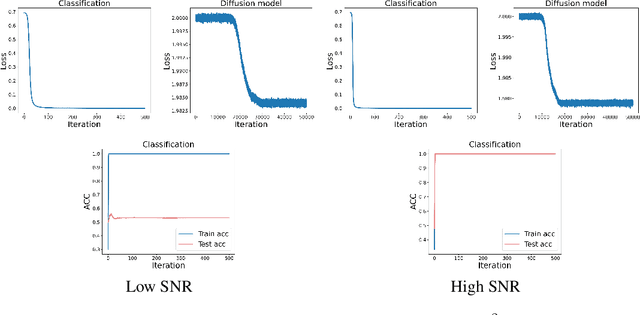Andi Han
Self-Contradiction as Self-Improvement: Mitigating the Generation-Understanding Gap in MLLMs
Jul 22, 2025Abstract:Despite efforts to unify multimodal generation and understanding tasks in a single model, we show these MLLMs exhibit self-contradiction where generation produces images deemed misaligned with input prompts based on the model's own understanding. We define a Nonunified score that quantifies such self-contradiction. Our empirical results reveal that the self-contradiction mainly arises from weak generation that fails to align with prompts, rather than misunderstanding. This capability asymmetry indicates the potential of leveraging self-contradiction for self-improvement, where the stronger model understanding guides the weaker generation to mitigate the generation-understanding gap. Applying standard post-training methods (e.g., SFT, DPO) with such internal supervision successfully improves both generation and unification. We discover a co-improvement effect on both generation and understanding when only fine-tuning the generation branch, a phenomenon known in pre-training but underexplored in post-training. Our analysis shows improvements stem from better detection of false positives that are previously incorrectly identified as prompt-aligned. Theoretically, we show the aligned training dynamics between generation and understanding allow reduced prompt-misaligned generations to also improve mismatch detection in the understanding branch. Additionally, the framework reveals a potential risk of co-degradation under poor supervision-an overlooked phenomenon that is empirically validated in our experiments. Notably, we find intrinsic metrics like Nonunified score cannot distinguish co-degradation from co-improvement, which highlights the necessity of data quality check. Finally, we propose a curriculum-based strategy based on our findings that gradually introduces harder samples as the model improves, leading to better unification and improved MLLM generation and understanding.
Generalization Bound of Gradient Flow through Training Trajectory and Data-dependent Kernel
Jun 12, 2025Abstract:Gradient-based optimization methods have shown remarkable empirical success, yet their theoretical generalization properties remain only partially understood. In this paper, we establish a generalization bound for gradient flow that aligns with the classical Rademacher complexity bounds for kernel methods-specifically those based on the RKHS norm and kernel trace-through a data-dependent kernel called the loss path kernel (LPK). Unlike static kernels such as NTK, the LPK captures the entire training trajectory, adapting to both data and optimization dynamics, leading to tighter and more informative generalization guarantees. Moreover, the bound highlights how the norm of the training loss gradients along the optimization trajectory influences the final generalization performance. The key technical ingredients in our proof combine stability analysis of gradient flow with uniform convergence via Rademacher complexity. Our bound recovers existing kernel regression bounds for overparameterized neural networks and shows the feature learning capability of neural networks compared to kernel methods. Numerical experiments on real-world datasets validate that our bounds correlate well with the true generalization gap.
Scalable Parameter and Memory Efficient Pretraining for LLM: Recent Algorithmic Advances and Benchmarking
May 28, 2025Abstract:Fueled by their remarkable ability to tackle diverse tasks across multiple domains, large language models (LLMs) have grown at an unprecedented rate, with some recent models containing trillions of parameters. This growth is accompanied by substantial computational challenges, particularly regarding the memory and compute resources required for training and fine-tuning. Numerous approaches have been explored to address these issues, such as LoRA. While these methods are effective for fine-tuning, their application to pre-training is significantly more challenging due to the need to learn vast datasets. Motivated by this issue, we aim to address the following questions: Can parameter- or memory-efficient methods enhance pre-training efficiency while achieving performance comparable to full-model training? How can the performance gap be narrowed? To this end, the contributions of this work are the following. (1) We begin by conducting a comprehensive survey that summarizes state-of-the-art methods for efficient pre-training. (2) We perform a benchmark evaluation of several representative memory efficient pre-training approaches to comprehensively evaluate their performance across model sizes. We observe that with a proper choice of optimizer and hyperparameters, full-rank training delivers the best performance, as expected. We also notice that incorporating high-rank updates in low-rank approaches is the key to improving their performance. (3) Finally, we propose two practical techniques, namely weight refactorization and momentum reset, to enhance the performance of efficient pre-training methods. We observe that applying these techniques to the low-rank method (on a 1B model) can achieve a lower perplexity than popular memory efficient algorithms such as GaLore and Fira, while simultaneously using about 25% less memory.
On the Role of Label Noise in the Feature Learning Process
May 25, 2025Abstract:Deep learning with noisy labels presents significant challenges. In this work, we theoretically characterize the role of label noise from a feature learning perspective. Specifically, we consider a signal-noise data distribution, where each sample comprises a label-dependent signal and label-independent noise, and rigorously analyze the training dynamics of a two-layer convolutional neural network under this data setup, along with the presence of label noise. Our analysis identifies two key stages. In Stage I, the model perfectly fits all the clean samples (i.e., samples without label noise) while ignoring the noisy ones (i.e., samples with noisy labels). During this stage, the model learns the signal from the clean samples, which generalizes well on unseen data. In Stage II, as the training loss converges, the gradient in the direction of noise surpasses that of the signal, leading to overfitting on noisy samples. Eventually, the model memorizes the noise present in the noisy samples and degrades its generalization ability. Furthermore, our analysis provides a theoretical basis for two widely used techniques for tackling label noise: early stopping and sample selection. Experiments on both synthetic and real-world setups validate our theory.
Efficient Optimization with Orthogonality Constraint: a Randomized Riemannian Submanifold Method
May 18, 2025Abstract:Optimization with orthogonality constraints frequently arises in various fields such as machine learning. Riemannian optimization offers a powerful framework for solving these problems by equipping the constraint set with a Riemannian manifold structure and performing optimization intrinsically on the manifold. This approach typically involves computing a search direction in the tangent space and updating variables via a retraction operation. However, as the size of the variables increases, the computational cost of the retraction can become prohibitively high, limiting the applicability of Riemannian optimization to large-scale problems. To address this challenge and enhance scalability, we propose a novel approach that restricts each update on a random submanifold, thereby significantly reducing the per-iteration complexity. We introduce two sampling strategies for selecting the random submanifolds and theoretically analyze the convergence of the proposed methods. We provide convergence results for general nonconvex functions and functions that satisfy Riemannian Polyak-Lojasiewicz condition as well as for stochastic optimization settings. Additionally, we demonstrate how our approach can be generalized to quotient manifolds derived from the orthogonal manifold. Extensive experiments verify the benefits of the proposed method, across a wide variety of problems.
Can Diffusion Models Learn Hidden Inter-Feature Rules Behind Images?
Feb 07, 2025Abstract:Despite the remarkable success of diffusion models (DMs) in data generation, they exhibit specific failure cases with unsatisfactory outputs. We focus on one such limitation: the ability of DMs to learn hidden rules between image features. Specifically, for image data with dependent features ($\mathbf{x}$) and ($\mathbf{y}$) (e.g., the height of the sun ($\mathbf{x}$) and the length of the shadow ($\mathbf{y}$)), we investigate whether DMs can accurately capture the inter-feature rule ($p(\mathbf{y}|\mathbf{x})$). Empirical evaluations on mainstream DMs (e.g., Stable Diffusion 3.5) reveal consistent failures, such as inconsistent lighting-shadow relationships and mismatched object-mirror reflections. Inspired by these findings, we design four synthetic tasks with strongly correlated features to assess DMs' rule-learning abilities. Extensive experiments show that while DMs can identify coarse-grained rules, they struggle with fine-grained ones. Our theoretical analysis demonstrates that DMs trained via denoising score matching (DSM) exhibit constant errors in learning hidden rules, as the DSM objective is not compatible with rule conformity. To mitigate this, we introduce a common technique - incorporating additional classifier guidance during sampling, which achieves (limited) improvements. Our analysis reveals that the subtle signals of fine-grained rules are challenging for the classifier to capture, providing insights for future exploration.
On the Feature Learning in Diffusion Models
Dec 02, 2024



Abstract:The predominant success of diffusion models in generative modeling has spurred significant interest in understanding their theoretical foundations. In this work, we propose a feature learning framework aimed at analyzing and comparing the training dynamics of diffusion models with those of traditional classification models. Our theoretical analysis demonstrates that, under identical settings, diffusion models, due to the denoising objective, are encouraged to learn more balanced and comprehensive representations of the data. In contrast, neural networks with a similar architecture trained for classification tend to prioritize learning specific patterns in the data, often focusing on easy-to-learn components. To support these theoretical insights, we conduct several experiments on both synthetic and real-world datasets, which empirically validate our findings and highlight the distinct feature learning dynamics in diffusion models compared to classification.
On the Comparison between Multi-modal and Single-modal Contrastive Learning
Nov 05, 2024

Abstract:Multi-modal contrastive learning with language supervision has presented a paradigm shift in modern machine learning. By pre-training on a web-scale dataset, multi-modal contrastive learning can learn high-quality representations that exhibit impressive robustness and transferability. Despite its empirical success, the theoretical understanding is still in its infancy, especially regarding its comparison with single-modal contrastive learning. In this work, we introduce a feature learning theory framework that provides a theoretical foundation for understanding the differences between multi-modal and single-modal contrastive learning. Based on a data generation model consisting of signal and noise, our analysis is performed on a ReLU network trained with the InfoMax objective function. Through a trajectory-based optimization analysis and generalization characterization on downstream tasks, we identify the critical factor, which is the signal-to-noise ratio (SNR), that impacts the generalizability in downstream tasks of both multi-modal and single-modal contrastive learning. Through the cooperation between the two modalities, multi-modal learning can achieve better feature learning, leading to improvements in performance in downstream tasks compared to single-modal learning. Our analysis provides a unified framework that can characterize the optimization and generalization of both single-modal and multi-modal contrastive learning. Empirical experiments on both synthetic and real-world datasets further consolidate our theoretical findings.
* 51pages, 1 figure, 1 table
Provably Transformers Harness Multi-Concept Word Semantics for Efficient In-Context Learning
Nov 04, 2024Abstract:Transformer-based large language models (LLMs) have displayed remarkable creative prowess and emergence capabilities. Existing empirical studies have revealed a strong connection between these LLMs' impressive emergence abilities and their in-context learning (ICL) capacity, allowing them to solve new tasks using only task-specific prompts without further fine-tuning. On the other hand, existing empirical and theoretical studies also show that there is a linear regularity of the multi-concept encoded semantic representation behind transformer-based LLMs. However, existing theoretical work fail to build up an understanding of the connection between this regularity and the innovative power of ICL. Additionally, prior work often focuses on simplified, unrealistic scenarios involving linear transformers or unrealistic loss functions, and they achieve only linear or sub-linear convergence rates. In contrast, this work provides a fine-grained mathematical analysis to show how transformers leverage the multi-concept semantics of words to enable powerful ICL and excellent out-of-distribution ICL abilities, offering insights into how transformers innovate solutions for certain unseen tasks encoded with multiple cross-concept semantics. Inspired by empirical studies on the linear latent geometry of LLMs, the analysis is based on a concept-based low-noise sparse coding prompt model. Leveraging advanced techniques, this work showcases the exponential 0-1 loss convergence over the highly non-convex training dynamics, which pioneeringly incorporates the challenges of softmax self-attention, ReLU-activated MLPs, and cross-entropy loss. Empirical simulations corroborate the theoretical findings.
Diffusing to the Top: Boost Graph Neural Networks with Minimal Hyperparameter Tuning
Oct 08, 2024



Abstract:Graph Neural Networks (GNNs) are proficient in graph representation learning and achieve promising performance on versatile tasks such as node classification and link prediction. Usually, a comprehensive hyperparameter tuning is essential for fully unlocking GNN's top performance, especially for complicated tasks such as node classification on large graphs and long-range graphs. This is usually associated with high computational and time costs and careful design of appropriate search spaces. This work introduces a graph-conditioned latent diffusion framework (GNN-Diff) to generate high-performing GNNs based on the model checkpoints of sub-optimal hyperparameters selected by a light-tuning coarse search. We validate our method through 166 experiments across four graph tasks: node classification on small, large, and long-range graphs, as well as link prediction. Our experiments involve 10 classic and state-of-the-art target models and 20 publicly available datasets. The results consistently demonstrate that GNN-Diff: (1) boosts the performance of GNNs with efficient hyperparameter tuning; and (2) presents high stability and generalizability on unseen data across multiple generation runs. The code is available at https://github.com/lequanlin/GNN-Diff.
 Add to Chrome
Add to Chrome Add to Firefox
Add to Firefox Add to Edge
Add to Edge